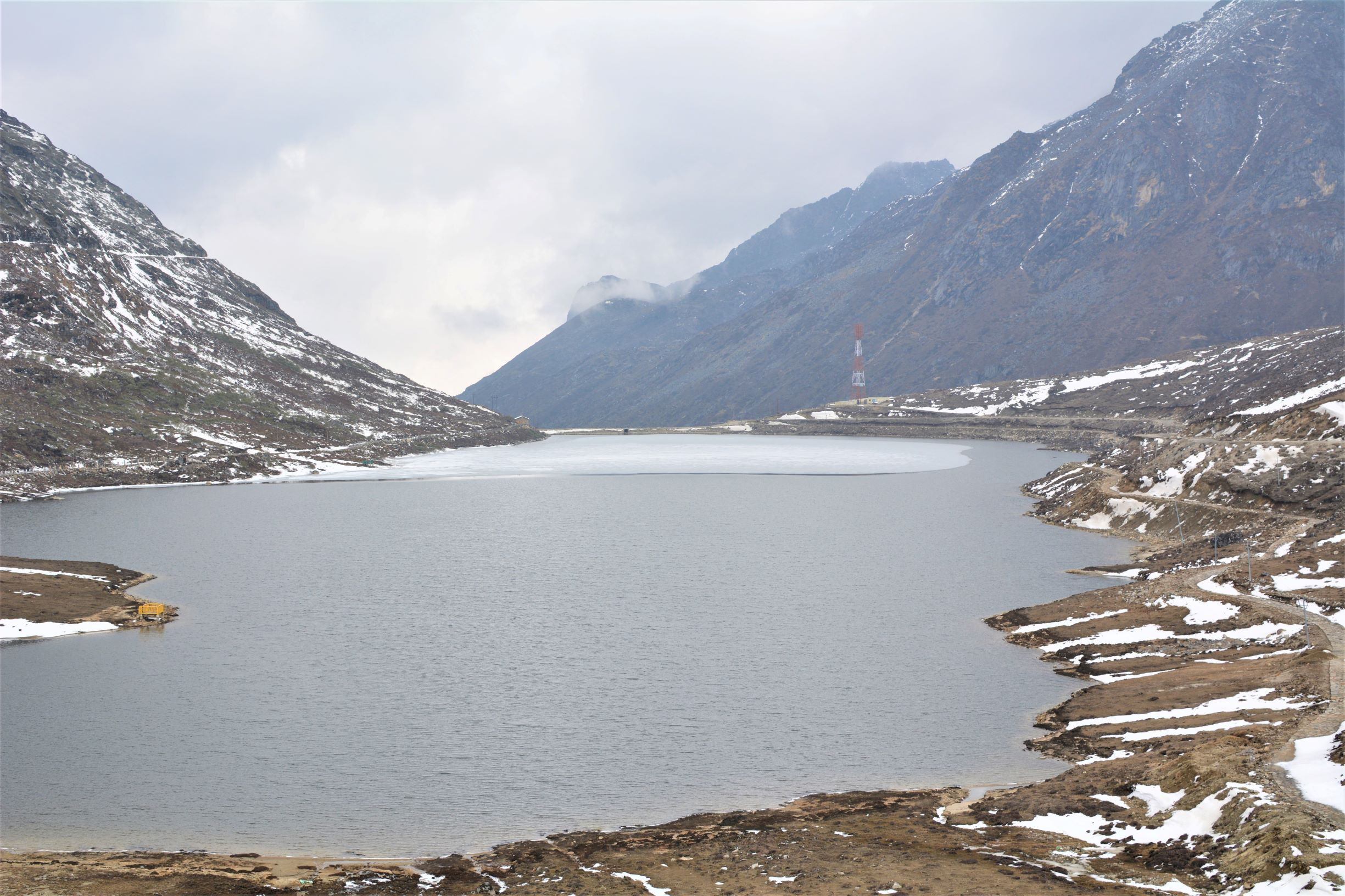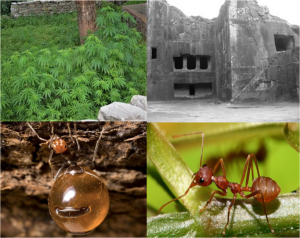With the threat of global warming and unpredictable climate looming over our heads, it is imperative that we understand the past climatic history of our planet to make any predictions about the future. Earth has had a violent climatic past, undergoing repeated warming and cooling phases. A long period of global cooling is known as an ice age. Earth has faced at least five major ice ages characterized by periods of global cooling and permafrost (permanent ice throughout the year) (Hewitt 2000). During an ice age, the polar and continental ice sheets along with the glaciers expand and cover large portions of the planet (Hewitt 2000) (Figure 1). Even within an ice age there are cycles of extended periods of global cooling, termed as “glacial periods”, punctuated by shorter intervals of a warmer climate, termed as “interglacials” (Hewitt 2004; Bintanja et al. 2005). We are currently living in an ice age which the scientists have named as the “Quaternary”.
The current ice age began ~2.58 million years ago with the beginning of the formation of the Arctic ice cap. For the last ~2.58 million years’ earth has undergone multiple cycles of glacial periods and warm interglacials (Hewitt 2000). During the glacial period, ice-sheets cover large portions of the northern and southern hemisphere and global temperatures fall by as much as 8 0C. As most of the water is locked up in ice during this period, global sea levels fall by up to 120m connecting various land masses especially in the Southern Hemisphere (Hewitt 2004; Bintanja et al. 2005; Jouzel et al. 2007) (Figure 2). However, during the warmer periods or the interglacials, ice retreats and the global sea levels rise to the present levels. We are currently in an interglacial period, which began ~15,000 to ~10,000 years ago. Interestingly, the initial glacial-interglacial cycles lasted for about 41,000 years, whereas now the cycles last for ~100,000 years and are much more pronounced (Hewitt 2000; Hewitt 2004).  Although, the theory of ice age was accepted in the late 19th century, the main reason for the occurrence of the ice ages are not completely understood. It is suggested that Earth’s axial tilt and its interaction with ocean current, atmospheric composition, distance from the sun and solar output are important drivers of global shifts in climate (Hewitt 2004).
Although, the theory of ice age was accepted in the late 19th century, the main reason for the occurrence of the ice ages are not completely understood. It is suggested that Earth’s axial tilt and its interaction with ocean current, atmospheric composition, distance from the sun and solar output are important drivers of global shifts in climate (Hewitt 2004).
Quaternary glaciation has had a strong impact on the world’s biodiversity and is especially well documented in the Northern hemisphere (mostly in North America and Europe). For example, during the glacial periods, large tracts of Europe were covered in ice (Figure 1) and UK was connected to continental Europe by land bridges. Whereas in North America ice sheets covered Greenland, Canada and northern parts of US. As ice covered most of the land, most species were forced into small pockets of habitat. These suitable habitats are known as “glacial refugia” (Hewitt 2000). 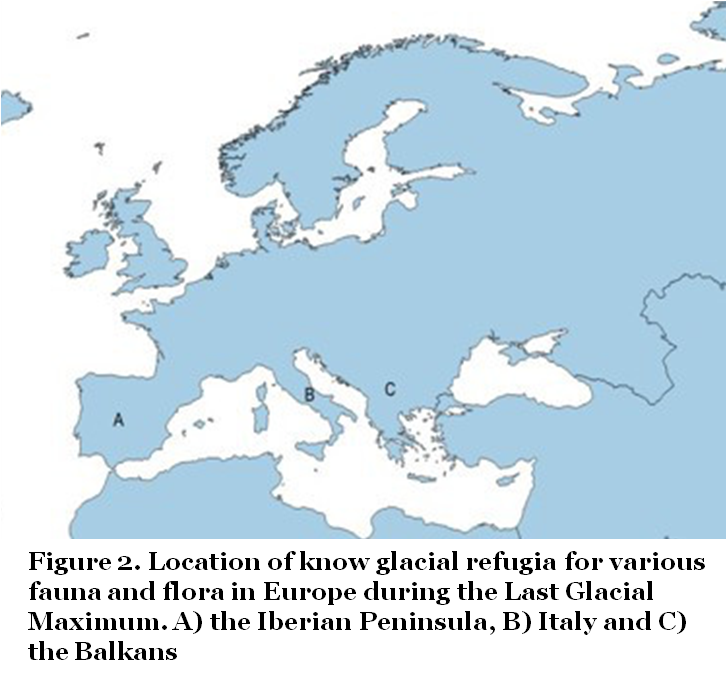 For example, in Europe during the glacial period, most species retreated to the Mediterranean basin and then expanded north only during the interglacial period (Hewitt 2000). The Iberian Peninsula (Portugal and Spain), Italy and Balkans were important glacial refugia for many species in Europe (Hewitt 2000) (Figure 2). Only when the ice retreated, most of Europe was recolonized. This occurred multiple times in the past 2.6 million years. Multiple such contraction and expansions have led to divergence within many species as different refugial populations remained isolated for prolonged periods before getting reconnected during interglacial intervals (Hewitt 2000). For example, the repeated cycles of climate cooling and warming led to the gradual divergence of western and eastern populations of meadow grasshopper, brown bear and field vole in the last one million years (Hewitt 2000). Another effect of the ice ages is that most of expanding populations have low genetic diversity (variation) due to founder effects, i.e., a few individuals genetically contributing to the population. As individuals are forced into refugial populations, only a small portion of the population survives which can expand its range and recolonize more areas once the suitable habitat is available. For example, scientists observed that the genetic diversity of old permafrost samples of brown bears (Figure 3A) was higher than fresh samples. Individuals from ~36,000 years ago had higher genetic diversity as they were a part of a larger population.
For example, in Europe during the glacial period, most species retreated to the Mediterranean basin and then expanded north only during the interglacial period (Hewitt 2000). The Iberian Peninsula (Portugal and Spain), Italy and Balkans were important glacial refugia for many species in Europe (Hewitt 2000) (Figure 2). Only when the ice retreated, most of Europe was recolonized. This occurred multiple times in the past 2.6 million years. Multiple such contraction and expansions have led to divergence within many species as different refugial populations remained isolated for prolonged periods before getting reconnected during interglacial intervals (Hewitt 2000). For example, the repeated cycles of climate cooling and warming led to the gradual divergence of western and eastern populations of meadow grasshopper, brown bear and field vole in the last one million years (Hewitt 2000). Another effect of the ice ages is that most of expanding populations have low genetic diversity (variation) due to founder effects, i.e., a few individuals genetically contributing to the population. As individuals are forced into refugial populations, only a small portion of the population survives which can expand its range and recolonize more areas once the suitable habitat is available. For example, scientists observed that the genetic diversity of old permafrost samples of brown bears (Figure 3A) was higher than fresh samples. Individuals from ~36,000 years ago had higher genetic diversity as they were a part of a larger population.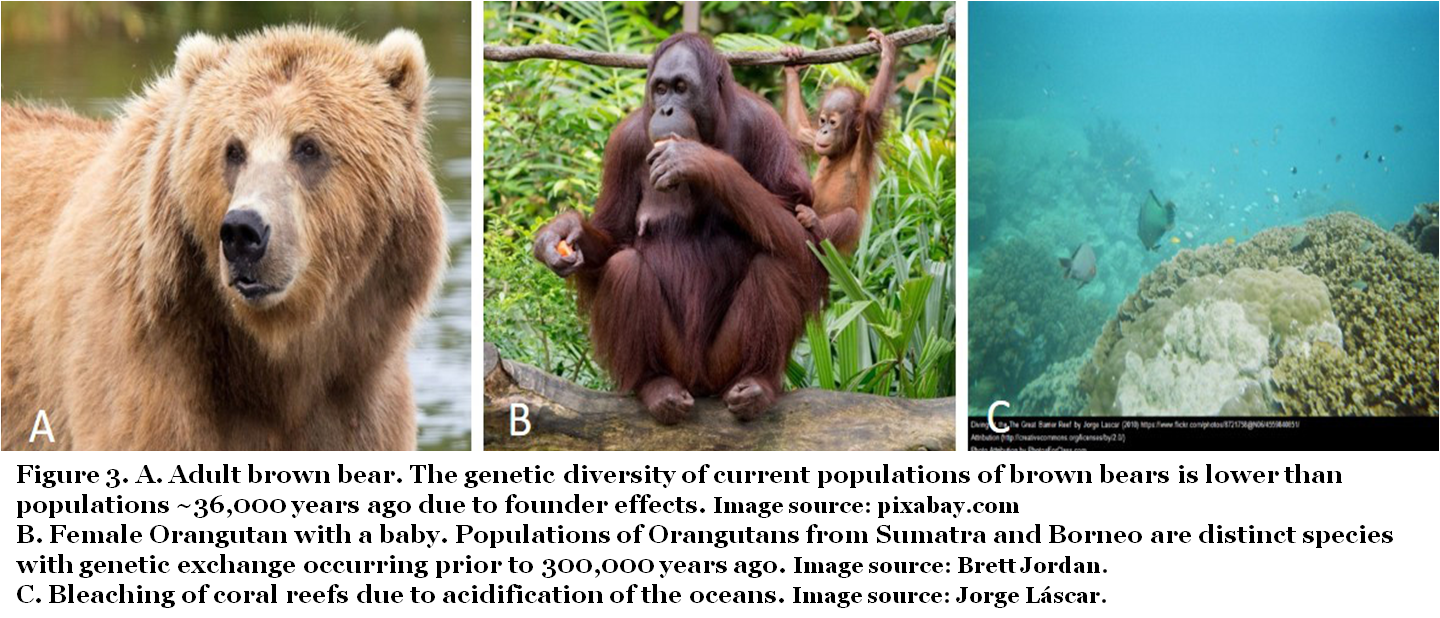 Around the Last Glacial Maximum (~20,000 years ago), Brown bears was then forced into small refugia, which have now expanded and current populations are derived from these small populations. Hence the genetic diversity of the current samples is lower compared to the historic samples (Leonard et al. 2000).
Around the Last Glacial Maximum (~20,000 years ago), Brown bears was then forced into small refugia, which have now expanded and current populations are derived from these small populations. Hence the genetic diversity of the current samples is lower compared to the historic samples (Leonard et al. 2000).
Interestingly, in the Southern hemisphere, many isolated island populations maybe connected during the ice ages as the sea level drops and land bridges are formed (Figure 4). The Sundaland, a major biogeographic region in South East Asia, is one the most extreme examples, where Peninsular Malaysia is connected to the islands of Sumatra, Java, Borneo along with associated islands and form a landmass twice the size of the current land area (Figure 4). These land bridges may connect many isolated populations and allow for the exchange of genetic material. For example, there were genetic exchanges between populations of Bornean and Sumatran orangutans at least till last 300,000 years ago (Natter et al. 2017) (Figure 3B). Although the Bornean orangutan is a different species from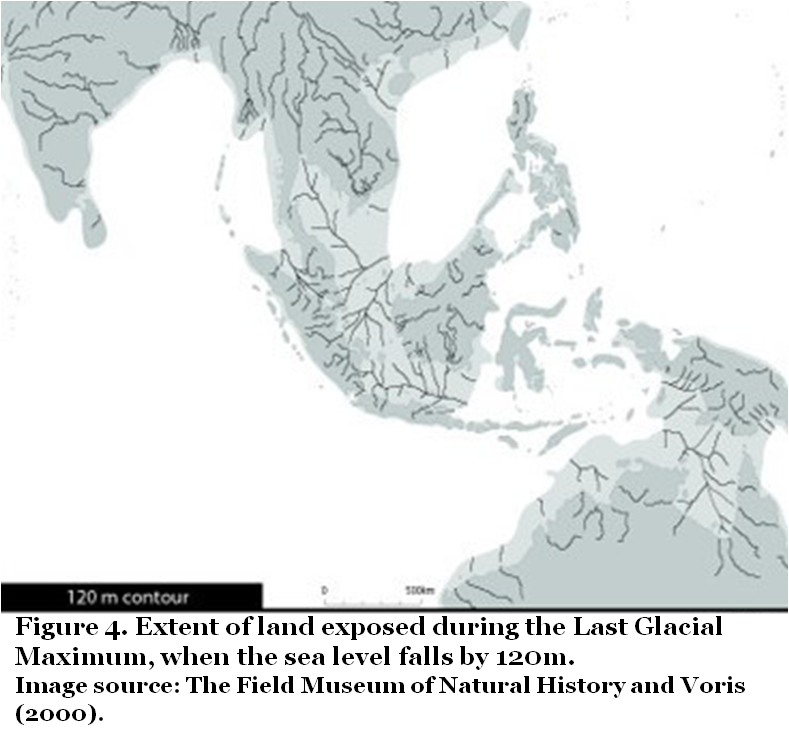 Sumatran orangutan, there has been genetic exchange between them whenever the sea level dropped and the Sunda shelf was exposed. Further, this process of connecting and disconnecting populations also allowed for speciation and a high level of endemism we observe in Sundaland. Sundaland is one of the 25 important biodiversity hotspots and second only to the Tropical Andes in terms of the number of endemics (Myers et al. 2010). Quaternary glaciation has helped in shaping the biodiversity we observe in Sundaland. Similarly, India and Sri Lanka also got connected (Figure 4), during the glacial periods and evidence of faunal exchange have been noted in a few species (Wickramasinghe et al. 2017). However, our understanding of gene flow between India and Sri Lanka is in its infancy and more data is required to get a better understanding.
Sumatran orangutan, there has been genetic exchange between them whenever the sea level dropped and the Sunda shelf was exposed. Further, this process of connecting and disconnecting populations also allowed for speciation and a high level of endemism we observe in Sundaland. Sundaland is one of the 25 important biodiversity hotspots and second only to the Tropical Andes in terms of the number of endemics (Myers et al. 2010). Quaternary glaciation has helped in shaping the biodiversity we observe in Sundaland. Similarly, India and Sri Lanka also got connected (Figure 4), during the glacial periods and evidence of faunal exchange have been noted in a few species (Wickramasinghe et al. 2017). However, our understanding of gene flow between India and Sri Lanka is in its infancy and more data is required to get a better understanding.
Given that the past climate has had a strong impact on shaping global biodiversity, it is imperative that we pay attention to our present climate and our contributions to global warming. In the past century, humans have had a strong impact on our planet. With the increase in atmospheric carbon dioxide emissions, we may have irreversibly changed our climate. Increase in atmospheric greenhouse gases have accelerated the global warming and current climatic models predict that we may permanently loose the Arctic ice cap in the next 20 to 30 years (Wang and Overland 2009). Arctic summers are already hotter than they were 115,000 years ago and increase warming may lead to longer unpredicted droughts, heavy flooding, stronger cyclones. Climate change has already had a strong impact on the current biodiversity. Many montane species are moving uphill as the temperatures increase and their habitats shrink. Increase in global temperatures have put enormous pressure on these populations, which extremely vulnerable to local extinctions. Similarly, increase in atmospheric carbon dioxide has led to acidification of oceans and coral bleaching (Figure 3C), wherein the corals expel the symbiotic algae from their tissue. These algae provide corals with nutrition and the loss of algae prevent future growth and leave the coral more susceptible to diseases. However, preventing the loss of biodiversity is dependent on us. With most countries agreeing to limit the increases in global temperature to less than 2 0C, we have a fighting chance to save the current biodiversity and prevent drastic effects of climate change.
References
- Bintanja R, van de Wal RS, Oerlemans J (2005) Modelled atmospheric temperatures and global sea levels over the past million years. Nature 437:125–128.
- Hewitt G (2000) The genetic legacy of the Quaternary ice ages. Nature 405:907–913.
- Hewitt G (2004) Genetic consequences of climatic oscillations in the Quaternary. Philos Trans Royal Soc B 359:183–195.
- Jouzel J, Masson-Delmotte V, Cattani O, Dreyfus G, Falourd S, Hoffmann G, Minster B, Nouet J, Barnola JM, Chappellaz J (2007) Orbital and millennial Antarctic climate variability over the past 800,000 years. Science 317:793–796.
- Leonard JA, Wayne RK, Cooper A (2000) Population genetics of Ice Age brown bears. Proc Natl Acad Sci U S A 97:1651–1654.
- Mangerud J, Jakobsson M, Alexanderson H, Astakhov V, Clarke GK, Henriksen M, Hjort C, Krinner G, Lunkka JP, Möller P, Murray A (2004) Ice-dammed lakes and rerouting of the drainage of northern Eurasia during the Last Glaciation. Quat Sci Rev 23:1313–1332.
- Myers N, Mittermeier RA, Mittermeier CG, Da Fonseca GA, Kent J (2000) Biodiversity hotspots for conservation priorities. Nature 403:853.
- Nater A, Mattle-Greminger MP, Nurcahyo A, Nowak MG, De Manuel M, Desai T, Groves C, Pybus M, Sonay TB, Roos C, Lameira AR (2017) Morphometric, behavioral, and genomic evidence for a new orangutan species. Curr Biol 27:3487–3498.
- Voris HK (2000) Maps of Pleistocene Sea Levels in South East Asia: Shorelines, River Systems, Time Durations. J Biogeogr 27:1153–1167.
- Wang M, Overland JE (2009) A sea ice free summer Arctic within 30 years? Geophys Res Lett 36
- Wickramasinghe N, Robin VV, Ramakrishnan U, Reddy S, Seneviratne SS (2017) Non-sister Sri Lankan white-eyes (genus Zosterops) are a result of independent colonizations. PloS One 12:e0181441.
About Author:


